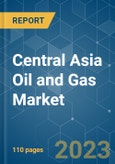The market was negatively impacted by COVID-19 in 2020. Presently the market has now reached pre-pandemic levels.
Key Highlights
- Over the medium term, the growing demand for natural gas is expected to stimulate the market growth of Central Asia oil and gas market. Furthermore, increasing investments and ambitious oil and gas production targets are expected to drive the growth of the market studied.
- On the other hand, lack of capital and technological advancement are expected to hamper the growth of Central Asia oil and gas market during the forecast period.
- Nevertheless, oil and gas discoveries in countries like Turkmenistan and Kazakhstan are likely to create lucrative growth opportunities for the Central Asia oil and gas market in the forecast period.
- Kazakhstan dominates the market and is also likely to witness the highest CAGR during the forecast period. This growth is attributed to the increasing investments, coupled with increase in oil and natural gas production.
Central Asia Oil & Gas Market Trends
Upstream Sector to dominate the market
- In Central Asia, most of the country's economically viable oil and gas fields are inland. Many countries, such as Kazakhstan, is the largest economy in Central Asia and are home to more than 18 million people. The country is rich in coal, oil, natural gas, and uranium. The government has recently seen significant growth in the country's exploration and production activities.
- Oil production in the region has grown by around 2.4% in the past five years. Although Kazakhstan produces some gas, most are re-injected to enhance oil recovery locally. On the contrary, most of the gas produced by Turkmenistan and Uzbekistan is exported to China, Russia, and Azerbaijan.
- Central Asia oil production amounted to 1,911 '000 barrels per day in 2021. The level of oil production reached an all-time high in 2019 at nearly 2,024 barrels per day. However, the coronavirus pandemic and its impact on transportation fuel demand led to a notable decline in the following year.
- In January 2022, territories adjacent to the Malay and Nayip gas fields in the Lebap region of Turkmenistan discovered new gas resources.
- The new gas was discovered in the lower layers of the Northern Dervush and Malay fields.
- In December 2021, the Government of Uzbekistan announced that government would invest USD 33 billion in the oil and gas sector by 2025, which will aid the upstream market in the region.
- However, the ongoing war between Russia and Ukraine has severely affected the economy, adversely affecting the region's oil and gas demand. For instance, in 2022, Kazakhastan plans to reduce oil production by 1.8 million tons due to economic shrinkage owing to the war.
Kazakhstan is Expected to Dominate the market
- Kazakhstan was the world's ninth-largest exporter of crude oil and 12th of natural gas as of 2021. As of December 2021, natural gas exported by Kazakhstan was 15,101.000 million cubic meters. The increase was primarily due to demand from Russian Federation and China.
- In 2021, oil production in Kazakhstan reached 1,811 '000 barrels per day, a slight increase from the previous year. In 2019, oil production reached the highest point in history.
- Natural gas production increased by 14.03%, i.e., from 27.8 billion cubic meters in 2010 to 32.7 billion cubic meters in 2021. Natural gas consumption increased by 22.06%, i.e., from 9.5 bcm in 2010 to 15.1 bcm in 2021. Therefore, the increasing demand for natural gas is boosting investments within the country.
- In 2021, the Ministry of Energy, Kazakhstan, announced USD 116.8 million for implementing 146 oil and gas projects across the country. The allocated budget is utilized for the extension of gas networks, providing access to gas for around 10,388 thousand people within the country.
- Moreover, in June 2021, Kazakhstan started the construction of a new gas processing plant in the Makat district in the Atyrau region, near the existing onshore Bolashak oil and gas treatment complex. The project has an investment cost of USD 860 million and can process 1 billion cubic meters/year of sulfur dioxide from the Kashagan field.
- In August 2022, Kazakhstan announced plans to sell some of its crude oil through Azerbaijan's most significant oil pipeline as the nation seeks alternatives to a route Russia threatened to shut. Kazakh oil exports account for more than 1 percent of world supplies, or roughly 1.4 million barrels per day (BPD).
- Hence, increasing investments in the oil and gas industry are expected to drive the market due to the addition of new capacity. Demand from neighboring countries like the Russian Federation and China is also expected to boost the market during the forecast period.
Central Asia Oil & Gas Market Competitor Analysis
The Central Asia oil and gas market is moderately consolidated in nature. Some of the major players in the market (in no particular order) include JSC Turkmengaz, Sinopec Oilfield Service Corporation, Gazprom International Limited, PJSC Lukoil Oil Company, Chevron Corporation, and National Company JSC (KazMunayGas).Additional benefits of purchasing the report:
- The market estimate (ME) sheet in Excel format
- 3 months of analyst support
This product will be delivered within 2 business days.
Table of Contents
Companies Mentioned (Partial List)
A selection of companies mentioned in this report includes, but is not limited to:
- JSC Turkmengaz
- Sinopec Oilfield Service Corporation
- Gazprom International Limited
- PJSC Lukoil Oil Company
- Chevron Corporation
- Intergas Central Asia JSC
- National Company QazaqGaz JSC
- KazTransOil JSC
- Shell PLC
- National Company JSC (KazMunayGas)










